B2B ecommerce is the process of marketing and selling products between two businesses online.
The goal is simple: expand customer reach and reduce cost-to-serve to drive more revenue for your business.
But how do you start a business in B2B ecommerce, and what does the future hold?
If you aren’t familiar with this ecommerce model, don’t worry. This guide will take you through how it works and how to get set up on a B2B ecommerce platform, as well as some successful B2B ecommerce examples to inspire your own operations.
How B2B ecommerce works
Business-to-business (or B2B) refers to selling products and services directly between two businesses.
As a business model, B2B differs significantly from B2C, where businesses sell directly to consumers. B2B ecommerce involves transactions between a manufacturer and wholesaler, or a wholesaler and a retailer, through an online sales portal.
B2B ecommerce is one of the fastest-growing sales models. Some estimates value the global B2B ecommerce market at over $12 trillion, taking up 13% of total B2B sales in the US.
Innovation and technology from B2B ecommerce platforms have helped drive the movement. B2B business traditionally involved labor-intensive, manual sales and marketing processes. The introduction of digital commerce helps these businesses reduce costs and improve efficiency through ecommerce automation.
B2B sellers work with:
-
Wholesalers
-
Large retailers
-
Organizations such as schools or nonprofits
-
Resellers
Buyers and sellers can now meet in one digital home, placing and managing orders from their mobile phones and creating new opportunities for businesses to connect with distributors and suppliers.
Automating the wholesale process changes how we build our team. It prevents us from missing 2 a.m. orders and keeps our customers from waiting to place an order until we’re in the office. It just solves so many problems.”
—Paul Hodge, CEO, Laird Superfood
Key advantages of B2B ecommerce include:
-
Automated sales processes between businesses, suppliers, and distributors
-
Reduced infrastructure and overhead costs
-
Less need for intermediaries
-
Higher growth prospects
-
Ability to reach a mass market at scale
-
Omnichannel branded presence available 24/7
-
Better partner relationships
-
High employee productivity
The COVID-19 pandemic exposed many weaknesses in supply chains and the many flaws in B2B workflows. The silver lining was the move to online selling. While it may seem daunting to move your entire B2B business online, those who do reap the benefits of better customer experience, streamlined ordering, and new revenue streams for their company.
Types of B2B ecommerce
If you’re just starting out in B2B ecommerce, you’ll likely fall into one of the following three categories. Each has its pros and cons, and many businesses operate in multiple categories simultaneously.
B2B2C
B2B2C, or business-to-business-to-consumer, sells directly to the consumer without using a middleman. Wholesalers or manufacturers produce goods. Those goods are then sold to B2B entities that sell them directly to the consumer.
In an ecommerce setting, a B2B2C business often includes a digital storefront showcasing their product catalog. The consumer may or may not know the product isn’t directly created by the business.
Wholesale
In a wholesale setup, businesses buy goods in bulk from distributors or manufacturers to then offer them for sale to the consumer at retail prices.
If you’re a wholesale supplier, buyer-oriented B2B marketplaces are a good way to advertise your products to buyers and retailers with less marketing effort. Buyer-oriented marketplaces exist where there are many buyers and fewer sellers.
Buyers in this case have their own online marketplaces. They invite suppliers and manufacturers to show their products and accept bids from different sellers.
Manufacturer
Manufacturers produce goods in large amounts that are then sold to other suppliers, wholesalers, or manufacturers. For example, a manufacturer might produce specialty shoelaces.
Those shoelaces are then sold to a luxury shoe manufacturer, where they assemble the shoe and add their branding. From there, completed shoes can be sold in bulk to wholesalers.
With the changing times, manufacturers are tasked with meeting digital demand. Wholesalers, suppliers, other B2B entities, and consumers are looking for increased flexibility in how they purchase manufactured items. Businesses are increasingly needing manufacturers to be able to complete online transactions with access to personalized features like pricing, production schedule, or sizing.
Distributor
Distributors take care of packaging, shipping, and marketing, which a manufacturer may not want to do in-house. Manufacturers have the option of partnering with distributors to sell their products.
A manufacturer and distributor partnership can be created online. By arriving at deals through an online platform, the manufacturer and distributor can achieve faster, more streamlined supply chains to meet or surpass customer expectations.
As you can imagine, amassing market share by offering an excellent customer experience is a competitive quest. This makes optimizing cost-effective distribution initiatives a must.
Take Fulfillment by Amazon as an example. Today, many new and established businesses are opting to outsource their fulfillment operations to cost-effective ecommerce giants like Amazon.
Stages of a B2B business
No single B2B business journey is the same. But there are a few overarching phases every B2B business goes through as they grow. Here’s a closer look at how a business goes from a startup to a mature and profitable operation.
Startup
Think of the startup phase as the spark phase where all ideas are fair game. At this stage, you’ve gone through the ideation process and have made a firm choice to start your B2B ecommerce business. You’re testing the market by picking an idea, bringing it to life, and getting those first few sales in.
The startup stage is the feedback stage. As you make sales (or fail to) and take in market feedback, this is the perfect time to be nimble and readjust to meet market demand.
There are several relevant key goals during the startup phase, including:
-
Validating your minimum viable product through sales
-
Ensuring your startup idea solves a problem and offers value
-
Figuring out your total addressable market (TAM)
-
Creating brand awareness
Yet reaching these goals isn’t going to happen without your fair share of startup challenges. At this stage, you may find out that your product flopped and that your audience isn’t as interested in buying what you’re selling. This happens because it’s easy to overestimate your knowledge of the market as a consumer yourself.
On the other hand, the complete opposite could happen. Demand for your product could be so high that you run out of the few goods you created for testing. As you scramble to create more, consumers get turned off by your out-of-stock announcement. Admittedly, the latter scenario is often the exception rather than the rule.
Most businesses struggle to make sales in the beginning and gain traction quickly. But that’s OK. It doesn’t necessarily mean your business idea isn’t a valuable one. As you listen to feedback, experiment with different iterations of your product, and sell to different segments of your market, you’ll eventually start to see growth. This takes us to the next stage.
Growth
At the growth stage, a few things are starting to come together for you. Your sales are increasing, they’re more predictable, and new customers discover you daily.
Here’s where you may start getting some room to experiment with offers, possible partnerships, and the chance to reinvest in the highest ROI areas of the business. The growth stage also means you’re constantly revisiting your systems, how you deal with supply chains, and reimagining your approach to operations.
Some goals at the growth stage are:
-
Seeking additional investor funding if that’s part of your growth strategy
-
Hiring key employees
-
Continuing to build supplier relationships
-
Experimenting with B2B marketing tactics
Growth can be painful. Markets change quickly, which means your businesses can be vulnerable to changing demands, costly mistakes, or fierce competition. Yet if done correctly, the growth stage eventually gets your business to the point where it’s ready to expand more aggressively.
Expansion
The expansion stage is where you can expect hockey stick growth—that is, growth is only going up and to the right according to your sales charts as you boost cash flow, move beyond breaking even, and diversify your distribution channels.
Depending on the needs of the market as well as the needs of your company, some common expansion goals can be:
-
Hiring top-notch talent
-
Developing a sustainable customer-support strategy
-
Creating a more sophisticated omnichannel marketing experience
-
Maintaining growth each quarter
Still, there are plenty of challenges at the expansion stage. Competition is likely fierce, you’re fighting to maintain market share, and revenue relies on critical budgeting decisions. But now you have resources to invest in solving those challenges and improving your offerings strategically.
Maturity
At the maturity stage, your sales are predictable, you can rely on future forecasts to maintain cash flow and growth, and you can hire as needed.
At this stage, you’re likely:
-
Looking to expand your product offering
-
Testing new markets
-
Investing in new technology
-
Considering potential exit strategies
-
Expanding your marketing campaigns to maintain growth
The maturity stage is where you precisely determine your profit margins. You’re familiar with your target market and know what they like, which means you constantly delight your customers with great customer support and a valuable product.
As a business owner, you have the choice to pivot, try something new, plan your exit strategy, or test new approaches to how you do business. At this stage, you’ve hit a huge milestone. You’ve made it. This means you can breathe easier and lean on reliable day-to-day operations, established business systems, and routines that ensure profitability.
B2B ecommerce marketing tactics
1. Kickstart growth with targeted ads
Paid ads haven’t gone anywhere. Despite the popularity of social media as a marketing platform for not only DTC audiences but B2B customers as well, paid ads are one of the fastest ways to gain traction in the early stages of growth if you have the startup capital for it.
Bravo Sierra, a men’s personal care brand, used paid Facebook ads to grow their customer base. A year later they were able to wean off paid ads by expanding its wholesale presence and using a distributor (Amazon) to take care of fulfillment.
2. Buy now, pay later
Think of Klarna, but for business-to-business transactions. Depending on your risk tolerance, businesses can work out deals with other companies that don’t have to require large upfront lump sums of cash.
Instead, consider creating buyer and supplier relationships that facilitate buy now, pay later payment terms, early payment discounts, or buyer loyalty programs, or even receiving a percentage of sales as payment.
3. Use partnerships
Sometimes the best growth path is through tapping into partnerships with other businesses. The key is striking a win-win deal that both companies are happy with.
Beis, a travel brand created by public figure Shay Mitchell, partnered with Beach House Group to bring their products to life. Shay had the public leverage to market a travel brand because of her online presence. Beach House Group had the industry expertise and connections to make it happen.
4. Offer speed
You can’t go wrong if your value proposition is to get products to consumers faster. If you can pull it off, it’s one of the best ways to grow sales and retain a customer base.
Instacart’s new Big & Bulky fulfillment branch is partnering with huge retailers to offer same-day delivery of large items like furniture, appliances, and electronics.
5. Use a distributor to fulfill orders cost-effectively
Going direct-to-consumer is becoming increasingly expensive across industries, as inflation rages and the price of everything increases. To remedy fulfillment expenses and keep a trim budget, consider using an intermediary distributor to take care of the fulfillment process.
Swoon, a beverage company, moved their back-end shipping operations to Amazon’s fulfillment services to lower expenses.
6. Eliminate order minimums
If possible, eliminate order minimums. As you sell to other businesses, flexibility is critical to boosting growth and maintaining buyer relationships. Eliminating order minimums opens the opportunity for smaller businesses and startups to make smaller orders as they gain traction on a budget.
For example, Printful does not require an order minimum when businesses use them to fulfill their merchandise orders.
7. Streamline the checkout process by optimizing the user experience
You no longer have to meet to close on $500,000 transactions in person. However, B2B businesses need to cover their bases when it comes to the buyer experience to make that possible. According to McKinsey, the B2B businesses that are thriving take their website user experience seriously by offering key features like:
-
Personalized recommendations
-
Better service availability
-
Improved warranty deals
-
Flexible shipping and delivery options

8. Make it easier for smaller businesses to buy from you
Catering to small businesses has plenty of revenue potential, if you’re able to provide deals and ease of access that other digital B2B companies don’t. As you refine your B2B ecommerce tactics, consider opening access to startup or growth-stage businesses by enabling affordable deals.
Take viaGlamour as an example. They’re a company that empowers small business owners to launch their own natural makeup line, small businesses to use payment plans, and everyone to get started for free. They even offer custom packaging design without dealing with a third party.
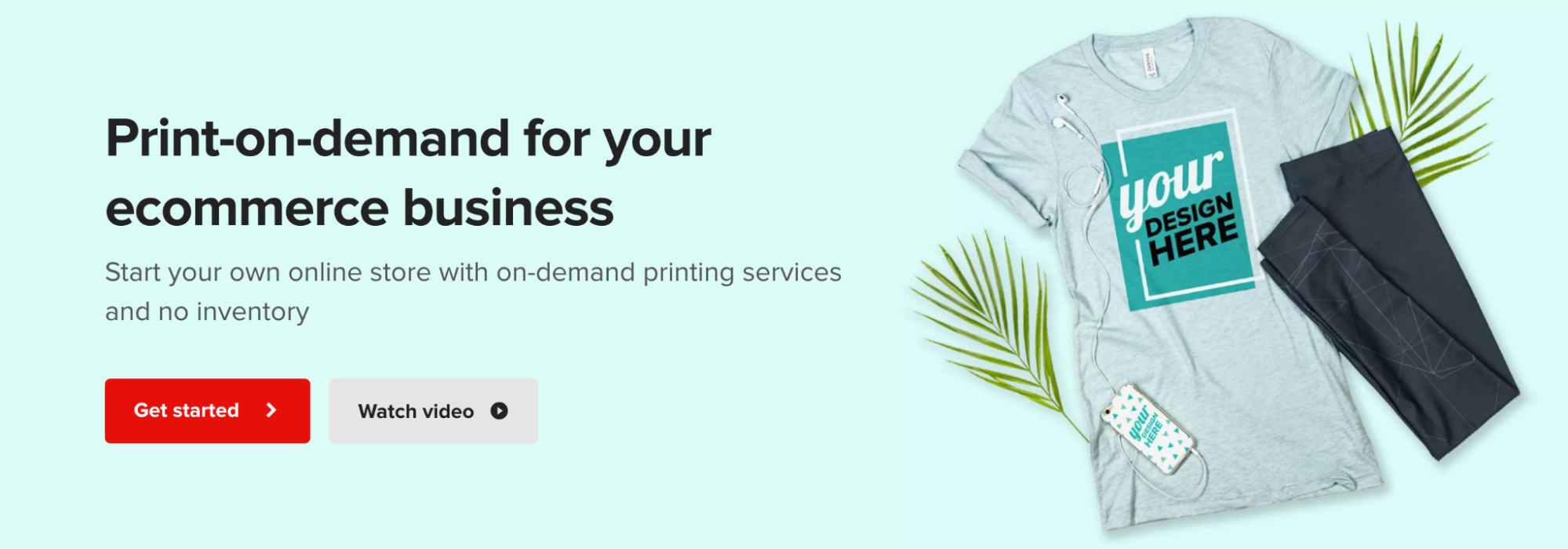
9. Execute omnichannel experiences
Content, SEO, paid ads, and a strong social media presence all come together to create an effective B2B omnichannel experience. Engagement and staying top of mind for businesses looking for what you offer is key. Whether that’s faster supply chains, highly discounted bulk purchases, or hyper-personalized fulfillment experiences.
B2B ecommerce myths
The B2B ecommerce industry is booming as B2B buyers get more comfortable making large transactions to the tune of $50,000 or more, without the need to meet face-to-face with suppliers. Still, despite the data, many B2B ecommerce myths still abound.
You might be familiar with the more common ones, including:
-
B2B companies aren’t able to offer ecommerce features that enable the buying process.
-
Digital B2B purchases only work for low-ticket transactions.
-
B2B companies aren’t working with sophisticated digital buying channels.
-
B2B digital marketplaces are nice-to-haves and not necessary for success.
Each of these myths couldn’t be further from the truth. The bottom line is that the digital approach to large B2B transactions only streamlines the supplier and buyer relationship. Suppliers are investing heavily in top-of-the-line websites where buyers can order thousands or even millions of dollars worth of products without needing to travel, spend time meeting in person, or wait to hear back on key production and scheduling information.
Business-to-business relationships are being revolutionized. The reality is that about 65% of B2B companies wholeheartedly embrace digital channels as a means for doing business—and doing it well. So well, according to McKinsey, it’s now the primary way a majority of B2B sellers prefer to do business.
Using a B2B ecommerce platform
Often B2B ecommerce businesses find themselves locked in legacy platforms, having traditionally relied on faxes, phone calls, and spreadsheets to sell to B2B customers.
Today businesses can take advantage of B2B ecommerce platforms to meet online customer needs. These platforms help create an online experience that drives sales and fulfills orders, no matter where your buyers are.
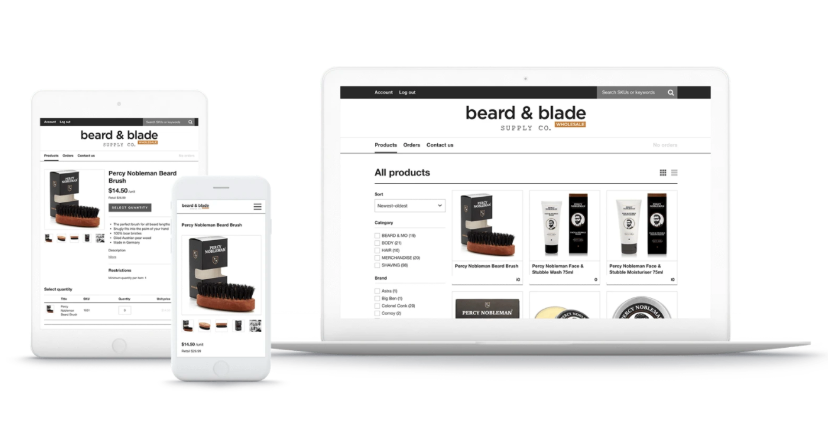
While many people think a B2B ecommerce platform is just a tool to list products and accept B2B payments, a true one is more than that. It acts as a command center, where you control everything from sales to commerce operations, whether it’s for B2B and wholesale customers or a D2C website.
For example, a B2B ecommerce site lets you:
-
Provide personalized sales and marketing experiences across sales channels and devices.
-
Help customers find products with onsite search and customized navigation.
-
Integrate customer data from your ERP or CRM through reliable APIs.
-
Offer flexible payment options with different payment providers and manual invoicing.
-
Optimize for conversion with powerful checkout promotions.
If you’re getting into wholesale ecommerce, a B2B ecommerce solution can drive sales by helping you:
-
Create custom pricing and discounts for specific customer segments.
-
Automate and review new buyer signups.
-
Allow B2B customers to buy, track, and reorder products easily.
-
Sync inventory, purchase orders, and customers with an existing ecommerce store or third-party software.
“It’s fair to say that having the wholesale portal will save us the equivalent of one employee a year. That’s $50,000 to $60,000 a year, and covers the cost of Shopify several times over.”
—Paul Hodge, CEO, Laird Superfood
In the end, a solid B2B ecommerce platform allows you to manage everything from one place, with endless growth opportunities. You can set up a password-protected and branded B2B online store with Shopify today, no coding required.
B2B ecommerce trends
Navigating B2B in ecommerce means understanding how B2B brands succeed. Let’s look at some B2B ecommerce trends we’re looking at for the future.
Give B2B ecommerce the B2C treatment
The rise of ecommerce has led to massive shifts in the overall B2B marketplace. Some of those changes have brought with them a host of best practices from the world of B2C:
-
High-quality product images and videos
-
Robust onsite search with visual merchandising
-
Social proof in the form of reviews and rating
-
Flexible shipping options and order updates
-
Personalization based on past purchases
-
Meant-for-mobile storefronts
-
Online catalogs for easy browsing
-
Real-time product and stock availability
-
Customer service via chat and phone support
Thankfully, meeting those challenges doesn’t require guesswork. Business customers rank the following B2C capabilities as increasingly essential to their online shopping experience:

-
Access to product information online
-
Personalized buyer experience and pricing
-
Ease and speed
Fortune 500 industrial supply company W. W. Grainger exemplifies this emerging overlap. After creating an account, buyers are directed to a homepage that mirrors any major B2C site. Likewise, their product pages bear all the B2C hallmarks listed previously:

But what sets Grainger apart as an online B2B pioneer are three additional features. First, three purchasing programs that go beyond auto-reordering to fit the size and needs of individual businesses:
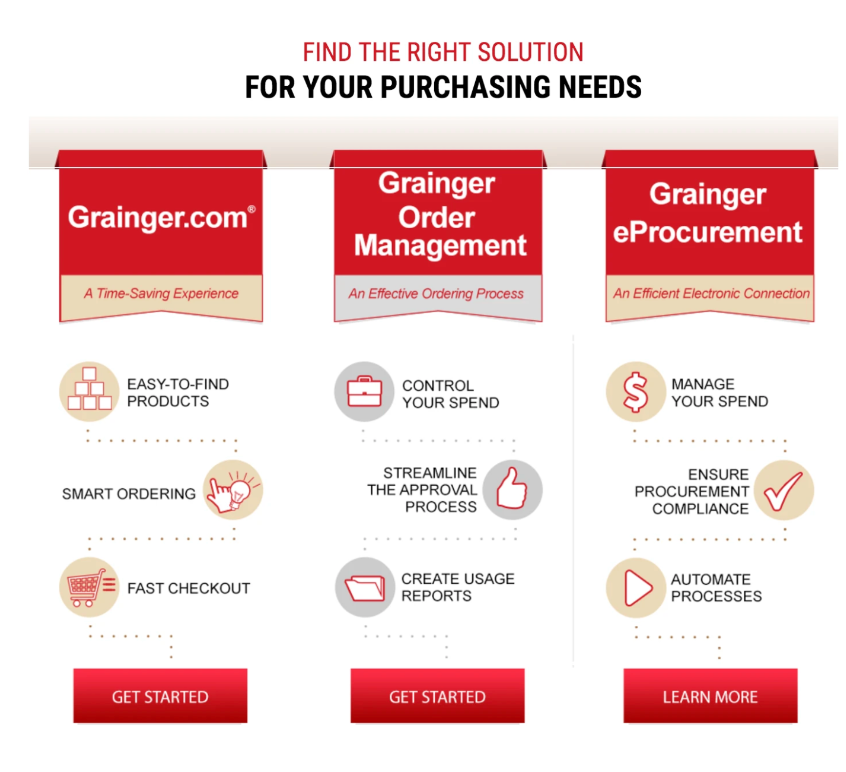
Second, a Bulk Order Pad toggle between two entry options is located immediately next to its search bar. And third, a robust, autocomplete search bar with Add to Cart options embedded:
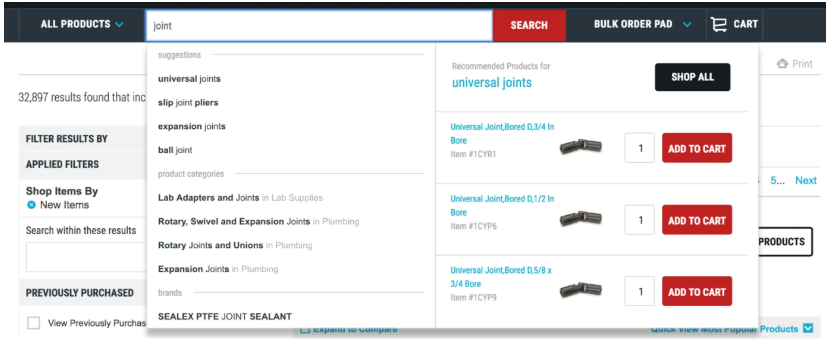
Given that 75% of B2B customers buy online and 47% do online research during the buying process, enhanced onsite search functionality is essential.
Enhance your onsite search functionality
If you sell a large catalog of thousands of car parts, it won’t be easy for customers to find what they’re seeking on your B2B ecommerce website in a pinch.
In the B2C world, site search is now a necessary function of a website. Just like an in-store sales clerk, it aids customers in finding and buying the right products. That’s because customers who use site search are almost two times more likely to convert to your site, and they can generate upward of 40% of your site’s revenue.
Enhancing your onsite search for B2B customers is equally important and helps streamline the sales process—empowering your sales reps to work in a more consultative rather than transactional role.
Mark Roberge, advisor and former chief revenue officer at HubSpot, explains: “You know you are running a modern sales team when selling feels more like the relationship between a doctor and a patient and less like a relationship between a salesperson and a prospect. It’s no longer about interrupting, pitching, and closing. It is about listening, diagnosing, and prescribing.”
The V-Belt Guys website isn’t exactly sexy or content-heavy. But it doesn’t need to be. Instead, it puts first things first.
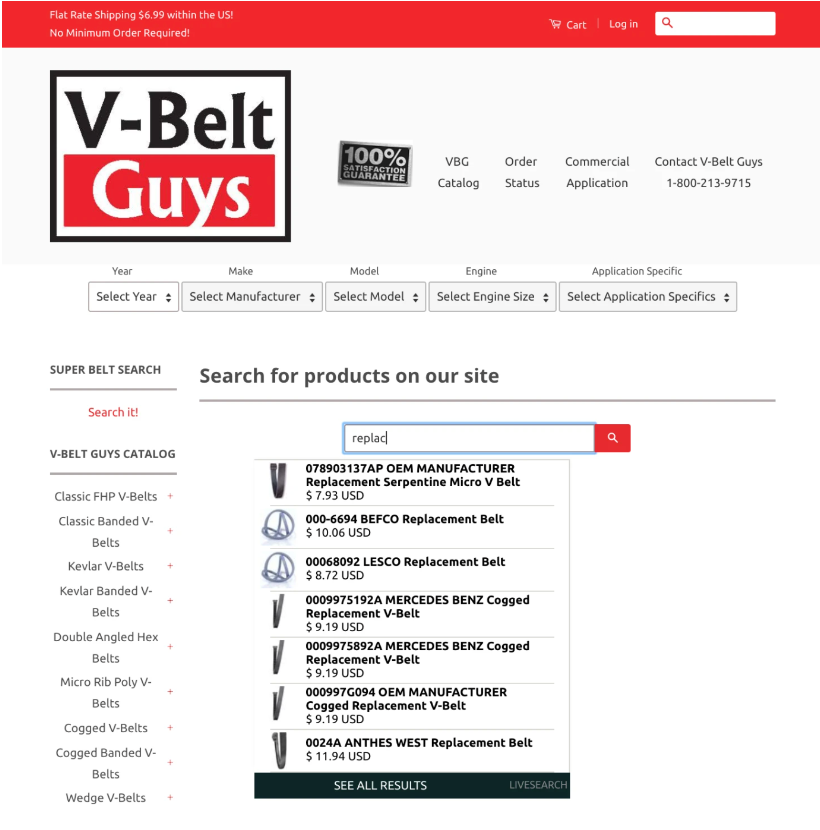
Their search strategy includes three separate invitations to submit a query on the homepage, plus word auto-completion and the ability to preview product images and prices while you type.
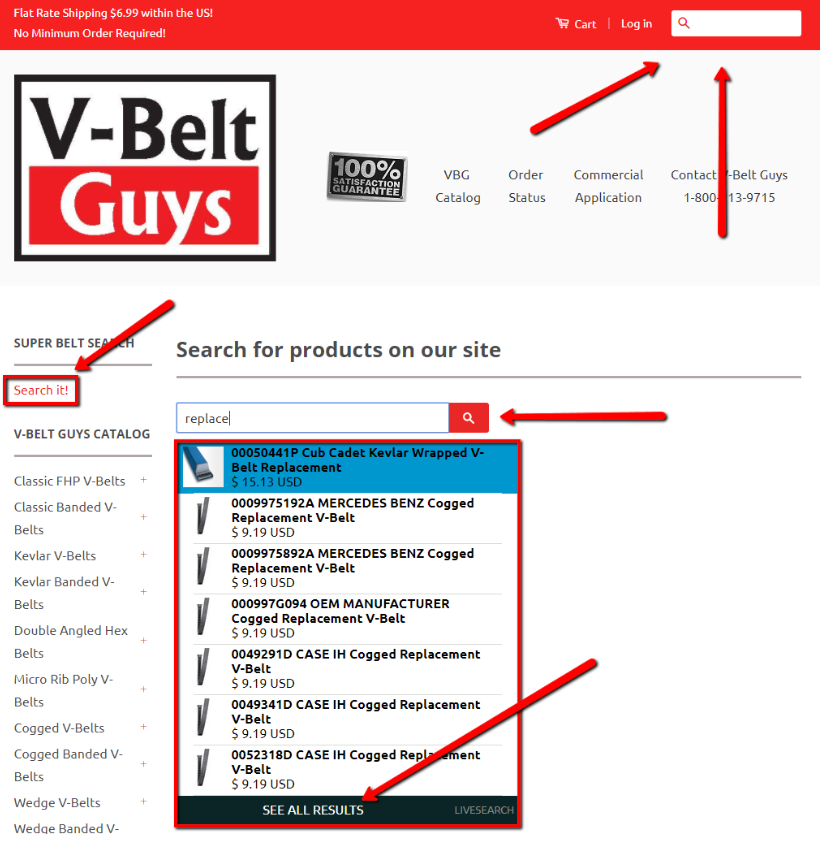
A customer can select “See all results” to get a full-screen experience, complete with price comparisons, bigger images, and detailed product descriptions.
To increase value, V-Belt Guys provides its visitors with key search elements like:
-
Part number
-
Manufacturer or brand
-
Part or full product title
-
Product type (e.g., product use cases)
-
Item details (e.g., width, function, and number of teeth)
This important service offering will assure customers that your B2B ecommerce business can help them find exactly what they need in a hurry. That’s a value proposition that generates repeat purchases—something that’s getting harder to do online.
Make wholesale easy on traditional customers
In the case of independent retail stores, small- to medium-sized franchises, and B2C outlets, some business buyers prefer simplicity over the bells and whistles of B2C ecommerce.
Catering to these types of buyers means offering them a digital version of the spreadsheets and faxed order forms they’re used to. Adding all the bells and whistles of B2C can become a distraction and even a detriment.
“The greatest myth around wholesale ecommerce is that it’s difficult to get your sales channel up and running,” says Pierre Verrier, director of design and development at Noticed. “Using Shopify and the Wholesale Channel is a fast and convenient way to get selling and give your customers the optimal portal to streamline their ordering process.”
For example, The Elephant Pants strikes a similar balance between B2B and B2C through their wholesale ecommerce platform on Shopify. This includes a number of the B2C elements already mentioned—namely, an easy-to-find search bar, quick access to previous orders, an online catalog for browsing, and transparent pricing:
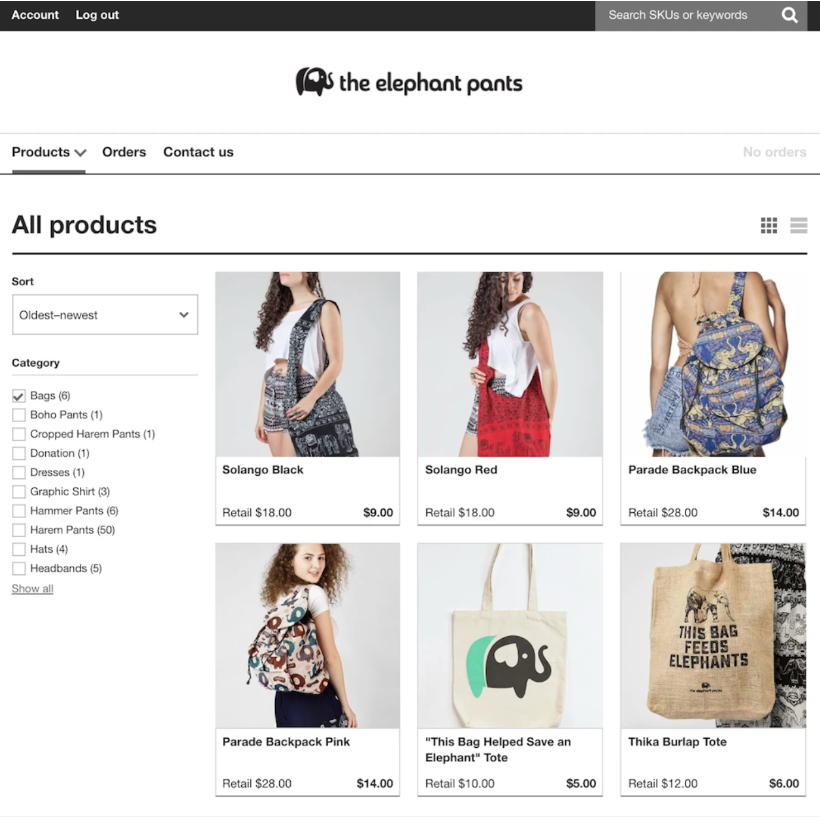
“Initially, some of our retail partners expressed resistance to an online wholesale portal,” explains James Brooks, CFO at The Elephant Pants. “For us, the move was about replacing our pieced-together method of phone calls and QuickBooks with something faster. For them, human guidance was still important.
“We’re in it together with our sellers. We advise them on purchasing and marketing, spec sheets, and POS displays.
“Because supporting them was crucial, we brought on a great sales rep and merged the physical with the digital.
“Today, we help 80% to 90% of our buyers create orders through the wholesale channel. The terms are determined on a buyer-by-buyer basis. As a result, wholesale has doubled for us over the last two months.”
Sometimes B2B needs to offer more than B2C. Sometimes, less.
In the case of resellers, small to medium franchises, and B2C outlets, less equals more. The simpler the order process, the more traditional your site should be. If your orders get complex—e.g., with customizations, multiple variants, or fulfillment options—the B2C treatment shines.
Everything comes down to the customers you serve. But before we turn to serving the people who can make deals, we must examine the people who can break them.
Read more: Wholesale Ecommerce: What is It and How to Start?
Generate B2B leads with agnosticism
Over 10 years ago, Seth Godin introduced the idea of permission marketing to describe the “privilege (not the right) of delivering anticipated, personal and relevant messages to people who want to get them.”
Even though Godin coined the term, the ethos of permission was far from original. How to be successful in life and how to market successfully have always had value at their core. Not value in the product per se—that should go without saying—but value in advance of the product.
As far back as the early 1930s, BBDO VP and creative director John Caples wrote:
“The best advertisements appeal to the reader’s self-interest—that is, advertisements based on reader benefits. They offer readers something they want—and can get from you.”
What was true then is still true today. Only more so.
As applied to B2B, this means generating leads through supplier-agnostic sales collateral. That might sound like a strange concept, but customers are inherently self-interested. The traditional method of leading with content that elevates your product, solution, or value proposition makes it about you.
The book The Challenger Customer frames the issue powerfully: “This is a big shift for marketers. For the majority of content types you produce, following this content strategy will shift the focus from supplier-centric to supplier-agnostic.”
In place of supplier-centric collateral, lead generation should focus on two types of problems central to your target customers’ own business:
-
Problems they’re aware of
-
Problems they don’t yet know exist
The lesson to take on board is that B2B in ecommerce lead generation can’t start with you; it has to start with your customer.
Businesses can use a content-based strategy to funnel customers’ different pain points to their products. Think of your content funnel like this:
-
Understand—to educate buyers
-
Select—to guide purchase decisions
-
Implement—for post-transaction support
When a new customer arrives at your site, they can learn more about their own problem and potential solutions. Instead of pitching products, your goal is to develop needed awareness so the buyer places real value on solving their problem.
Of course, stories are far more powerful in many cases than feature lists and product specifications. That’s why a great deal of the B2B marketing at Shopify is customer-centric rather than product-centric.
Instead of making the product the hero, our aim in storytelling is to make the business the hero.
By relentlessly zeroing in on the problems your market faces, you force yourself not only to turn away from self-centered sales and marketing but to earn your future customer’s “permission” before the sales process begins.
“Leads from those [content] initiatives were nurtured with in-depth educational content to help them understand the value of collaboration and how to evaluate different solutions,” says Amy Barzdukas, CMO of WiTricity. “This approach enabled us to build a trusted relationship for traditional, sales-focused follow-up, like demos and product details.
“The benefits of creating content for each stage of the buyer’s journey are shorter sales cycles, higher conversion rates, and increases in our marketing-sourced pipeline and revenue.”
Success means getting “permission” at the top of the funnel and only then progressing down the funnel with collateral that sells explicitly.
Humanize your B2B through social media
Despite its undeniable rise in B2C ecommerce, social media has remained largely a mystery to B2B businesses. Networks like Facebook, Instagram, and even LinkedIn are primarily viewed as direct-to-consumer channels.
Nonetheless, Content Marketing Institute’s 2020 B2B Report found that social media was the leading organic content distribution channel B2B marketers are using:
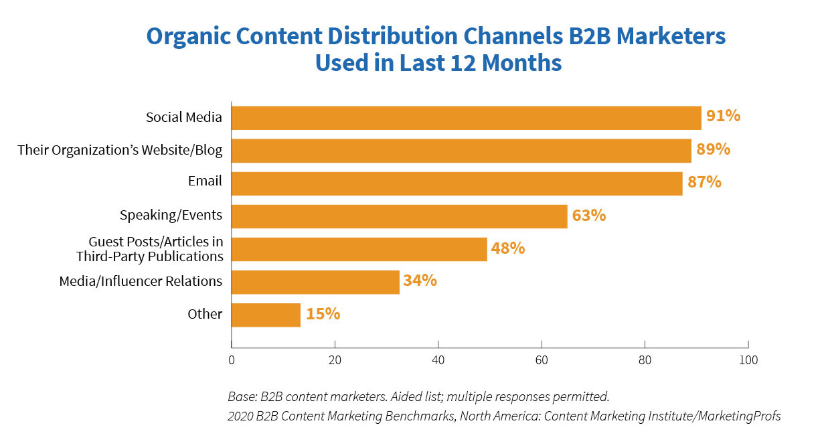
While social media may not work for direct sales in B2B, it is a powerful source for both outreach and creating the kind of consensus that B2B decision-making necessitates. Why? Because consensus is about people, and people connect with people.
“Social selling,” note Laurence Minsky and Keith A. Quesenberry in their Harvard Business Review article, “concentrates on producing focused content and providing one-to-one communication between the salesperson and the buyer.… [T]he goal is for the rep to form a relationship with each prospect, providing suggestions and answering questions rather than building an affinity for the organization’s brand.”
In the next practice, we’ll look at a real-world example of how to form those relationships. For now, rest assured that effective social selling—creating native content for multichannel marketing—only requires salespeople (or brands) to invest 5% to 10% of their time actively engaging one on one.
And that’s not to say brand affinity isn’t effective as well.
In 2015, GE created one of the most successful B2B campaigns in history through a Twitter character named the Invention Donkey. In its aftermath, GE credited the campaign with over 3.5 million views, 200,000 social media interactions, and—above all—giving their B2B audience a human touchpoint to what could otherwise be a faceless 140-year-old multinational conglomerate.
Tim Roan—the creative director behind the project—said, “The challenge for a lot of big companies is that it’s hard to simplify complex stories. GE is doing some very big, very important, and very hard things to help make the world work, and we wanted to show that in a fun, smart way.”
The role of social media in bringing together multiple decision makers is one that Troy Osinoff—who led digital marketing at the $5 billion B2B enterprise Watsco—drives home as well:
“B2B brands should look at social to build human relationships with the people who ultimately decide whether to use their product or service. Your social media presence and campaigns are an opportunity to create connections with everyone, from the gatekeepers to key decision makers.
“Social media is uniquely positioned to not only disseminate information like white papers and research but to connect and rally people around your brand.”
Such connections may start with a bit of fun, but they also have to progress.
Price with both automation and negotiation
According to Forrester research, 74% of B2B buyers now research “at least half of their work purchases online.” And 53% complete those purchases online as well.
Today’s B2B buyers insist that B2B ebusiness and channel strategy professionals match B2C companies like Amazon by incorporating B2C tenets of price transparency, immediacy, and convenience into their core buyer experiences.
As we’ve already seen, this doesn’t mean that B2C and B2B experiences are one for one. The keyword in Forrester’s appraisal is “price.”
The balance here is about price personalization that’s automated (i.e., dynamic) for buyers in the research phase and negotiated for those closer to purchase.
All of this is good news for B2C merchants thinking about moving into B2B or wholesale. Instead of recreating the wheel, a compelling B2B site should integrate the best practices your existing site already provides.
To segment the two audiences, Shopify makes creating multiple storefronts easy. Plus, apps like Locksmith let you password protect specific product collections and create subscriber-only sales and content.
For automatic pricing, Shopify Scripts offers a simple solution by removing the need for discount codes. Scripts can be used to automatically adjust prices in real time based on factors like quantity, size, customer tags, and product combinations:
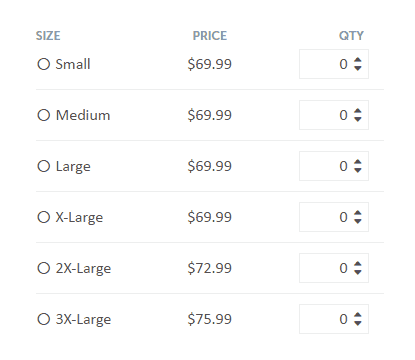
For negotiated deals, pricing must be tailored on a buyer-by-buyer basis. This includes:
-
Creating multiple price lists for fixed, percentage, or volume discounts
-
Applying those lists to individual customers or groups
-
Setting minimum, maximum, and quantity increments per product
-
Establishing minimum purchase amounts storewide or per customer
-
Reviewing draft orders before invoicing for negotiated deals
-
Integrating loyalty and reward programs automatically
The central theme is personalization: the flexibility to allow different customers to see and select different pricing.
To accommodate this, Shopify’s wholesale channel has three types of pricing lists, which can be used to create as many or as few lists as your business needs. Each list can then be applied either to individual customers or customer groups—e.g., “Gold-level-customer” and other tags.
These types of features are why the most successful B2B brands are moving toward cloud-based commerce platforms. It helps support new strategies and can help scale operations.
For all its complexity, the B2B opportunities are enormous. Succeeding online means taking advantage of an emerging world that mixes B2C best practices with both traditional and non-traditional B2B tactics.
Five successful B2B ecommerce examples
In B2B ecommerce—where $12 trillion is on the line annually—finding a way to short-circuit the path to hard-won experience is invaluable.
As a quote often attributed to Warren Buffett puts it: “It’s good to learn from your mistakes. It’s better to learn from other people’s mistakes.” Better still is learning from other people’s successes.
This isn’t a round-up post and is not a beauty contest.
But it is a detailed examination, ranging from international tech conglomerates to chocolates, and from baby carriers to model trains.
1. General Electric: B2B goes direct to consumer
Founded in 1892, General Electric is the very definition of an international B2B conglomerate. In 2017, it was ranked the 13th-largest enterprise in the United States on the Fortune 500. That kind of history and size is not without its difficulties.
As Tim Roan—the creative director behind GE projects like The Boy Who Beeped—told AdAge: “The challenge for a lot of big companies is that it’s hard to simplify complex stories. GE is doing some very big, very important and very hard things to help make the world work, and we want to show that in a fun, smart way.”
One of the ways GE does that is through creative storytelling, like with its Ideas Are Scary campaign.
But where branding rubber meets the ecommerce road is in GE’s direct-to-consumer (D2C) sites, like C by GE. Beautifully designed and interactive, C by GE opens a door for consumers to experience the future of light.
By creating direct-to-consumer access points, large B2B companies can test products and omnichannel marketing initiatives with the same agility of newly funded startups.
2. eJuices: Help resellers sell “direct”
If Nicotine River is the grown-up incarnation of liquid nicotine, then eJuices is their millennial-focused counterpart. That ethos shines, especially through their onsite visuals.

Still, don’t let eJuices’ B2C vibe fool you. While they excel at customer-facing B2C touches in both their branding and user experience, eJuices is a B2B wholesaler. And that means supporting its retail partners is top priority.
In addition to customer-friendly features like robust search, a rewards program, and “average lead time” for each and every product, eJuices’ Direct option solved what can often be a sale stopper in B2B business: inventory.
Rather than force retail partners into large, upfront purchases, the company has created a virtual warehouse.
What’s more, instead of a densely worded terms of service PDF, their explainer video details the process beautifully.
The takeaway here isn’t only to know your niche and communicate with it naturally but to invest in tactics that lower the risk for resellers.
3. ScaleTrains: Tell them when it’s coming
Hobbyists are a notoriously passionate group. After all, the more time and energy someone invests in an art form, sport, or craft, the stronger their emotions become.
Catering to hobbyists in the B2B realm means never giving them a needless reason to complain. Chief among needless complaints—no matter what business you’re in—is failing to provide a clear schedule for delivery.
In other words, the trains have to run on time. That’s all the more vital when trains are what you sell.
Puns aside, Scale Trains—an “upstart model train manufacturer”—doesn’t just set clear expectations on shipping timelines through their checkout process. It’s built an entire page dedicated to getting in front of product availability before it becomes an issue.
In this case, two lessons stand out. First, your own delivery schedule doesn’t have to be a dry spreadsheet of dates and inventory. Instead, it can and should embrace the aesthetic of your market itself. And second, never miss an opportunity to add scarcity to your buyer’s journey (e.g., listing a product as “extremely limited”).
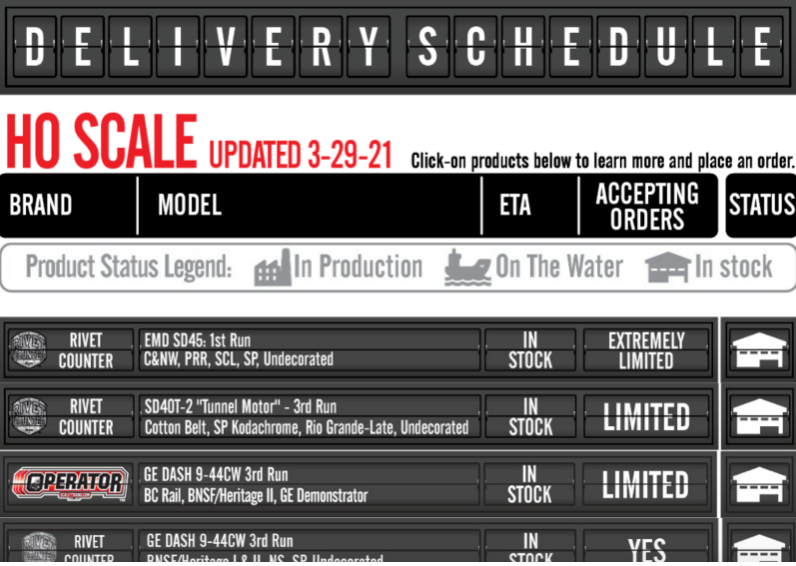
4. Chocomize: On-page SEO is a secret weapon
In B2C ecommerce, search engine optimization (SEO) is cutthroat. On-page best practices—like featuring each product’s keywords in page titles, H tags, body copy, and alt image tags—are table stakes, but the war over backlinks is what separates page one from all the rest.
Here’s a secret. In B2B, on-page SEO can still be a powerhouse of ranking and revenue.
Take Chocomize as a test case. Makers of personalized chocolates and other corporate gifts, Chocomize’s minimum orders start between 250 and 600 units, with significant discounts going to purchases closer to 10,000. With order volumes like that at stake, you’d be tempted to think that Google’s top search results would belong to online Goliaths like Godiva, Lindt, and Etsy.
Not so.
Chocomize’s homepage isn’t just on page one of Google for “personalized chocolate bars,” it’s also the number one result for both “custom chocolate bars” and “custom corporate chocolate.”

“We focused on a few key improvements,” explains Jacob McMillen, SEO consultant for Chocomize. “The first was getting meta tags for their high priority pages in order. Meta tags need to target both the search engine and the user. Google heavily factors user behavior into their algorithms, so if you can get people clicking on your listing, it will rise the results.
“The second thing we did was improve and expand page content. We turned the top pages into in-depth presentations that channeled visitors to specific product categories. Finally, we added internal links to help channel the domain’s authority to the top pages we wanted to rank.”
The SERPs speak for themselves.
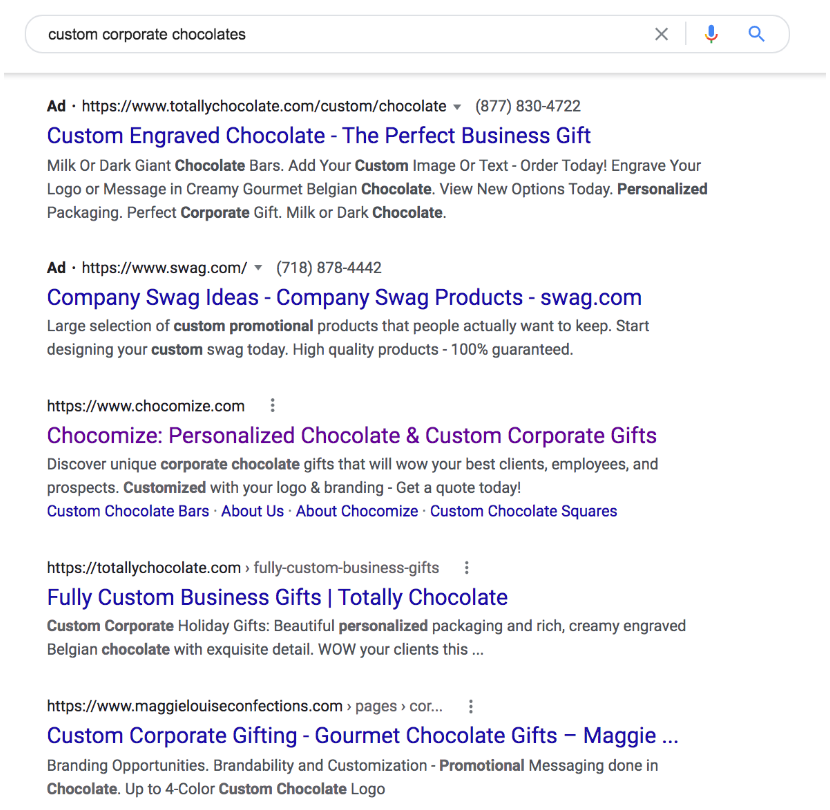
It’s true. Examples can never fully replace experience. But examples can make us wiser and more successful, with much less pain.
5. Printful: Democratize merchandise design
You’re probably familiar with the term print on demand. It’s what Printful does for small businesses that want to purchase products online, add their own design and branding ideas, and resell them for a profit.
In other words, where merchandise design used to have a huge barrier to entry because of startup costs, Printful has been one of the many on-demand companies that have successfully democratized the merchandise design industry.

It doesn’t hurt that their inception coincides with the growth in demand for ecommerce. Thanks to it, Printful could boast 80% growth in revenue in 2021 and $150 million in revenue in 2022.
Printful has been able to see stellar revenue numbers because they capitalized on solving a few key B2B problems:
-
Printful takes care of inventory for you making it easier and more cost-effective for businesses of all sizes to manage their supply chain.
-
Unlike traditional wholesalers, they don’t require businesses to order minimum amounts of products.
-
Printful eliminates the need for costly upfront investment. You only pay for fulfillment and shipping once an order comes in.
-
They can sell and ship your custom merchandise locally and internationally, enabling higher growth potential and better margins
Printful is a prime example of how B2B ecommerce businesses can win if they focus on an overarching idea: ease of access. The easier it is for other businesses to operate, the more revenue you stand to gain.
Whether you focus on serving your audience’s needs, optimizing your on-site or off-site search, supporting your retail partners, or making wholesale easy, a great place to start is to pick up at least one lesson from these five B2B ecommerce examples and use their wins for yourself.
The future of B2B ecommerce
The trend is obvious: B2B ecommerce is a major sales channel in digital commerce. Changes in buyer behavior due to the pandemic will continue to drive adoption further beyond 2021. Forrester forecasts that B2B ecommerce transactions will breach $1.8 trillion by 2023, which would account for 17% of all B2B sales in the United States.
Of course, emails and phone calls continue to have their place in B2B business. Still, there’s no question about it—ecommerce pushes the boundaries of what B2B sales could be.
This is great news for B2B sellers, because buyers are changing. Nearly 73% of millennials, a generation that grew up around technology, are now involved in the B2B buying process. These new buyers expect convenience and relevance more than their baby boomer and Generation X counterparts.
Personalized sales portals, mobile ordering, AR tours, self-service functionality—B2B platforms continue to pave the way for cost-effective and accessible selling opportunities.
Think about what that means:
-
You can reach a mass audience with less resources.
-
You can personalize relationships at scale.
-
Your customers now have the power to serve themselves.
The rise in B2B ecommerce is not only a pandemic trend. Buyers and sellers are moving toward digital commerce because it streamlines operations and boosts efficiency. And this trend will carry through this year and beyond.
Make your B2B ecommerce website
As you can see, B2B ecommerce is a great way to find new customers and increase sales for your business. Whether you’re building an online storefront, improving inventory management, or streamlining your recording process, a B2B ecommerce platform can help you get there.
Shopify hosts a large ecosystem for customer support and award-winning Agency Partners, ready to guide you at every step of your journey.
Those are just two of the reasons—along with a dedicated wholesale channel for B2B sales—our merchants are growing 120% year over year.
Read more
- 15 B2B Ecommerce Examples and What You Can Learn From Them
- Reverse Logistics: How to Process Returns Quickly, Easily, and Efficiently
- Hypefest 2018: O2O Examples from the Forefront of Marketing & Retail
- You Have 1/20th of a Second: Does Your Site Gain Trust in Time?
- How to Use a What-if Analysis to Measure the Effects of Your Decisions
- Microcopy: Near Invisible Text That Converts Visitors to Customers (Even When They Don’t Read It)
- Best Ecommerce Tools: 39 Apps to Grow a Multimillion-Dollar Business Online
- Harnessing the Power of Feedback Loops to Build a Business Customers Can't Resist
- What Is Curbside Pickup (Click and Collect)?
- Microservices: Advantages and Disadvantages (And Whether They're Right For Your Business)
Common Questions Related to B2B ecommerce
What's the difference between B2B and B2C ecommerce?
While B2B ecommerce involves one business buying from another business, B2C ecommerce involves an individual buying from a business.
What are the characteristics of B2B ecommerce?
Some of the key characteristics that differentiate B2B ecommerce from B2C ecommerce include multiple decision-makers and a longer time-to-purchase.
How do I start a B2B ecommerce company?
To start a B2B ecommerce company, you’ll first need to decide what you want to sell and evaluate whether there’s market demand. You’ll also need to set up an ecommerce website to list the products you’ll be selling.
Which is more profitable, B2B or B2C?
B2C sales are only about a third of the size of B2C sales, making B2B ecommerce the most profitable model in terms of global gross merchandise volume.
Is B2B ecommerce growing?
Yes, B2B ecommerce is growing and is expected to continue growing in the coming years. According to a report by Statista, B2B ecommerce sales are projected to surpass $1.8 trillion in the US alone by 2023. The COVID-19 pandemic has also accelerated the pace of B2B ecommerce growth as more businesses have turned to online channels to sell and purchase goods and services. The convenience, cost-efficiency, and speed of B2B ecommerce make it an attractive option for businesses of all sizes. Businesses are also adopting B2B ecommerce to expand their customer base and reach new markets.


